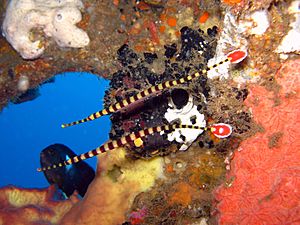Banded pipefish facts for kids
The banded pipefish or ringed pipefish (Dunckerocampus dactyliophorus) is a cool type of fish. It's part of the same family as seahorses and other pipefish, called Syngnathidae. These fish are known for their long, thin bodies and unique ways of raising their young.
Quick facts for kids Banded pipefish |
|
|---|---|
 |
|
| Conservation status | |
| Scientific classification | |
| Synonyms | |
|
Where Do They Live?
Banded pipefish live in warm, tropical waters across a huge area called the Indo-Pacific region. This includes places like the Red Sea, Australia, Japan, the Philippines, and many other islands.
You can find them in different watery spots. They like tide pools, which are small pools left behind by the ocean at low tide. They also live in calm lagoons and on the outer edges of reefs, where the ocean floor drops off.
What Do They Look Like?
The banded pipefish has a long, straight body. It can grow up to about 19 centimeters (or 7.4 inches) long. That's about the length of a regular pencil!
They have special fleshy bits that stick out from their head. Scientists think these bits help the pipefish hide. They act like camouflage, helping the fish blend in with plants and reeds in the water. This makes it harder for predators to spot them.
-
The skeleton of a banded pipefish (Museum of Osteology)
How Do They Have Babies?
Banded pipefish have a very interesting way of reproducing, just like seahorses. It's the male pipefish who carries the babies!
The female pipefish lays her eggs into a special pocket on the male's body. This pocket is called a brood pouch. The eggs then develop safely inside this pouch. After the eggs have grown, the male pipefish gives birth to tiny baby pipefish.
See also
 In Spanish: Dunckerocampus dactyliophorus para niños
In Spanish: Dunckerocampus dactyliophorus para niños





